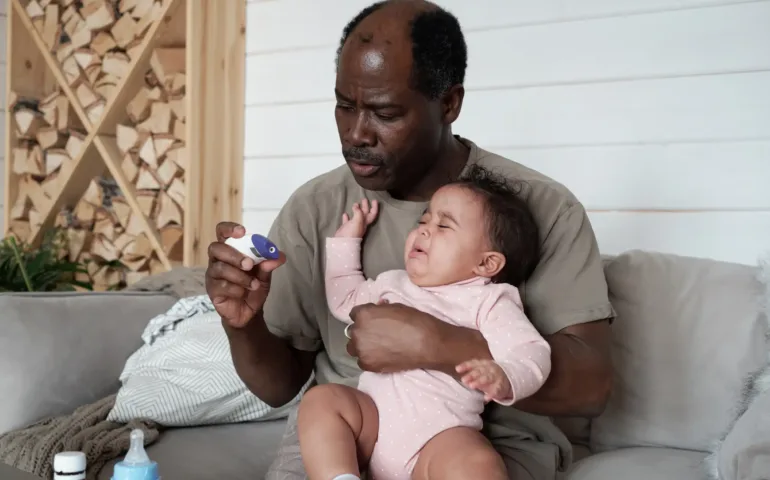
The “terrible two” seems to be an unavoidable stage in a child’s development that can really test a parent’s patience. Yet, this period is not necessarily intense for every child — and above all, it’s completely normal. This phase of opposition, where “no” becomes part of daily life, is essential for your child to learn to assert themselves and often comes with tantrums and meltdowns that can be hard to manage. How should you react, and how can you help your child through this phase? Terrible twos: let’s take a closer look.
What is the “terrible two”?
The terrible twos phase is a common stage in your child’s development, marked by a period of opposition that usually begins around 18 months and can last until age 3 or 4. Borrowed from the English term “terrible twos,” it describes a phase where the child starts to assert their independence and explore their limits.
During this time, your child may be more irritable, more sensitive, and may say no to everything: no to taking a bath, eating dinner, coming home from a walk, or leaving the park… These reactions are natural expressions of frustration. Your child may also cry or scream to express anger or displeasure in a situation they cannot control.
This phase of opposition is crucial because it helps your child build their own identity and develop social and emotional skills. They are testing the limits set by parents and their environment — which may seem like excessive or difficult behavior but is entirely normal and part of their growth. Above all, your child is learning to make choices and become an active participant in their own life — which is invaluable for their future!
The causes of the terrible twos
The terrible twos are often dreaded by parents but are a normal part of development. They are marked by tantrums, tears, and behaviors that may seem like tantrums or “acting out.” Understanding the underlying causes of these behaviors can help you respond more calmly and appropriately.
The development of independence
Your child begins to feel a strong need for independence. They want to do everything on their own and push boundaries set by others. This need is natural and an essential part of identity formation. As child therapist and author Isabelle Filliozat explains, this phase of opposition is a crucial step in helping the child differentiate themselves from their parents and assert who they are.
Why is independence important?
- It helps your child develop self-confidence.
- It encourages them to explore and learn by doing.
- It allows them to understand the consequences of their actions.
However, this quest for autonomy can lead to constant “no’s” and tantrums when your child feels restricted. It’s important to explain rules clearly and offer limited choices to meet their need for independence while keeping a secure framework.
Overwhelming emotions
Young children don’t yet have the tools to manage all their emotions. Their brains are still developing, making it hard to handle frustration and strong feelings. They may cry, scream, or express anger explosively.
Why do emotions overflow?
- Your child’s cognitive abilities are immature, making emotional regulation difficult.
- They don’t yet know how to verbalize their feelings, which can lead to outbursts.
- Rapid changes in their environment or routine can be stressful.
To help your child manage their emotions, it’s essential to provide a safe space where they can release tension. Encouraging them to put words to their feelings can also be very helpful. 
Tips for managing the terrible twos
The terrible twos may seem overwhelming, but there are practical tips to help your child (and you!) navigate this phase more peacefully. Here are two essential approaches to handle crises and maintain a calmer environment.
Establish routines
Routines play a crucial role in your child’s development. They provide comforting structure and predictability, which are essential during this phase of opposition. By creating consistent habits, you help your child understand what’s coming and feel safe.
Why are routines important?
- They create a sense of stability and security.
- They reduce frustration by setting clear expectations.
- They prevent meltdowns by offering a predictable framework.
- They limit conflict because they support parental guidance.
To create effective routines, start with key daily moments like mealtime, bath time, and bedtime. Explain each step so your child knows what to expect. For example, you might say, “After dinner, it’s bath time, then we’ll read a story before bed.” This can reduce frustration and help your child transition calmly.
Encourage communication
If your child doesn’t yet have strong language skills, this can lead to frustration and anger when they can’t express their emotions. To minimize this, communication is key!
How to encourage communication:
- Use simple words to describe your child’s emotions.
- Encourage them to use words to express anger rather than shouting or crying, even if sometimes a release tantrum is still necessary.
- Introduce role-play or books about emotions to help them understand and verbalize what they feel.
By adopting a positive, empathetic approach and taking time to understand this transitional phase, you’ll help your child move through it more peacefully. 
Preventing crises
Here are some strategies to help your child navigate this phase more smoothly:
- Lead by example by reducing your own use of “no.” We often don’t realize how many times we say it daily. Try replacing it with “yes, but…” when possible.
- Listen actively: take the time to understand what’s going on in your child’s mind. Encourage them to express their emotions with simple words — for instance, “I see you’re angry because you don’t want to put your toys away.” This validates their feelings and shows you’re listening.
- Try to make things playful whenever possible — turn transitions into games or small challenges.
- Use the power of choice to turn potential conflict into an opportunity for autonomy. Offer limited options: “Do you want the red coat or the blue one?” This gives a sense of control. Sometimes, you can’t avoid a tantrum — but often, offering small choices helps a lot.
- Don’t forget to take breaks. Kids sometimes need downtime to release emotions. A minute of calm can help them refocus. Try using a calming phrase like “Let’s take a break now.”
- Also, try to reduce fatigue by ensuring your child gets enough rest and naps. A tired child is less able to communicate or handle frustration.

A temporary phase
Getting through the terrible twos takes patience. The tantrums and outbursts during this stage can challenge even the most patient parents. It’s not always easy to see the bright side — but rest assured, this period is temporary and won’t last forever (phew!).
Try to put yourself in your child’s shoes to better manage difficult moments. Children in this stage of opposition don’t always know how to express anger other than by crying or screaming. As parents, you can guide them by explaining that their emotions are normal and encouraging them to talk about them.
It’s not always easy to stay calm in the face of repeated tantrums. Don’t hesitate to ask for help or step out for a minute to breathe when you feel overwhelmed.
Here are a few tips to handle these moments:
- Observe: take time to understand your child’s frustrations.
- Set clear boundaries: a secure framework helps children feel safe while still expressing emotions appropriately.
- Encourage emotional expression: help your child put words to feelings to reduce aggression and strengthen your bond.
The terrible twos are a normal stage of opposition in your child’s development as they learn to make choices and build their identity. It generally occurs between 18 months and 3 years old. To support your child, encourage them to verbalize emotions and turn conflicts into games or small challenges. Remember, it’s temporary — things will calm down with time!
Want to learn more? Feel free to download the May app, where you’ll find plenty of resources to support and guide you throughout your journey as a new parent.

Photos: zamrznutitonovi | Prostock-studio | kookkaibuu | YuriArcursPeopleimages | nikoletta21
This text was translated from French by an artificial intelligence. The information, advice, and sources it contains comply with French standards and may therefore not apply to your situation. Make sure to complement this reading by visiting the May US/UK app and consulting the healthcare professionals who are supporting you.



